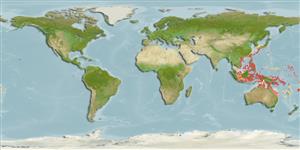>
Gobiiformes (Gobies) >
Gobiidae (Gobies) > Gobiinae
Etymology: Eviota: No etymology given, suggested by Christopher Scharpt: from Latin 'eu' for 'true' and 'iota' for anything very small, in combination 'truly very small' referring to it as being the smallest vertebrate at the time it has benn described by Jenkins (thus, making the suggestion by Scharpt plausible; shimadai: Named for Kazuhiko Shimada; noun in genitive case.
Eponymy: Kazuhiko Shimada works at the Okinawa Prefectural Fisheries and Ocean Research Center. [...] (Ref. 128868), visit book page.
More on authors: Greenfield & Randall.
Environment: milieu / Klimaatzone / Diepte / distribution range
Ecologie
marien rifbewoner; diepte 0 - 29 m (Ref. 83982). Subtropical
Western Pacific: Japan, Philippines, Palau and Indonesia.
Grootte / Gewicht / Leeftijd
Maturiteit: Lm ? range ? - ? cm
Max length : 1.6 cm SL mannelijk / geslacht onbekend; (Ref. 83982); 1.5 cm SL (female)
Korte beschrijving
Determinatiesleutels | Morfologie | Morfometrie
Dorsale stekels (totaal) : 7; Dorsale zachte stralen (totaal) : 8 - 9; Anale stekels: 1; Anale zachte stralen: 7 - 8. This species is distinguished from its congeners by the following set of characters: dorsal/anal fin-ray formula usually 8/8, sometimes 8/7 or 9/8; pectoral fin rays 16-17 (usually 16), all unbranched; cephalic sensory-pore system pattern IV (lacking pores PITO and IT, AITO enlarged, engulfing the PITO); fifth segmented pelvic-fin ray variable, absent to 18% of fourth ray; non-fimbriate genital papilla; filamentous first dorsal fin (second spine 67.2% SL in holotype); branches on fourth pelvic-fin ray 2-3, 2-3 segments between branches; body with no distinct large dark marks; side of body with scattered internal melanophores, under pectoral fin and on side of head; presence of silver bar across central part of pectoral-fin base when alive (Ref. 83982); characterized further by semi translucent body with irregular, internal reddish midlateral stripe; presence of rows of small reddish spots along dorsal midline; usually with several narrow reddish bars above base of anal fin; longitudinal scale series 23-24; sctenoid scales, absent on head, nape and base of pectoral fin; depth of body 4.3-5.0 in SL (Ref. 90102).
Body shape (shape guide): fusiform / normal.
Inhabits sheltered reefs in 3-20 (Ref 90102).
Levenscyclus en paargedrag
Maturiteit | Voortplanting | Paaien | Eieren | Fecunditeit | Larven
Greenfield, D.W. and J.E. Randall, 2010. Four new gobiid fishes of the genus Eviota from the Western Pacific, with clarification of Evoita guttata and Evoita albolineata (Teleostei: Goblidae). Proc. Calif Acad. Sci. 61(3):269-289. (Ref. 83982)
Status op de Rode Lijst van het IUCN (Ref. 130435: Version 2025-1)
Gevaar voor de mens
Harmless
Gebruik door de mens
Tools
Speciale rapporten
Download XML
Internetbronnen
Estimates based on models
Preferred temperature (Ref.
123201): 25.1 - 29.3, mean 28.7 °C (based on 973 cells).
Fylogenetische diversiteitsindex (Ref.
82804): PD
50 = 0.5000 [Uniqueness, from 0.5 = low to 2.0 = high].
Bayesian length-weight: a=0.01023 (0.00477 - 0.02194), b=3.01 (2.83 - 3.19), in cm total length, based on LWR estimates for this (Sub)family-body shape (Ref.
93245).
Trofisch niveau (Ref.
69278): 3.0 ±0.3 se; based on size and trophs of closest relatives
Weerstandsvermogen (Ref.
120179): Hoog, minimale populatieverdubbelingstijd minder dan 15 maanden (Preliminary K or Fecundity.).
Fishing Vulnerability (Ref.
59153): Low vulnerability (10 of 100).
🛈
